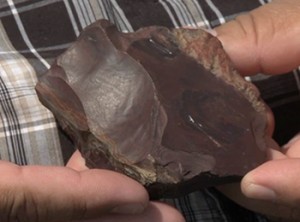
L’mu’juiktuk Cape d’Or
In this video, Gerald Gloade shares some of the stories about Cape d’Or—one of the most storied places in Mi’kma’ki.
The towering cliffs of Cape d’Or extend out into the Bay of Fundy, west of Parrsboro, Nova Scotia. It is said that explorer Samuel de Champlain named this point Cap d’Or (Arm of Gold) in the 1600s because of the golden colour of the copper shining in the cliffs. For the Mi’kmaq, it was the veins of hard and dense rock found in these basalt cliffs, as well as the copper, that had great value.
Minerals like chocolate chert (shown below) found in these cliffs are ideal for tool making. Chert is “knappable,” meaning it can be chipped and flaked to make sturdy, sharp-edged tools like scrapers, projectile points and knives.
Evidence of stone knapping by our ancestors can still be found on these beaches today.



 sharing our stories
sharing our stories
This was a very helpful explanation and it would be wonderful to see a QR Code added to the signage at Cape d’Or as I don’t recall the Mi’kmaq perspective being shown on the signs. I am wondering about coal in the Mi’kmaq culture. We learned a great deal about coal mining on our visit to Nova Scotia last summer, and learned a history of it. Is there an alternate perspective? Thanks and great site!
Thank you so much for sharing your knowledge Gerald.
You’re welcome! Anytime!
Thank-you for your short study of tool-making at Cape D’Or . I’d like to know more! Could you suggest, please, related reading material?
I know this area very well and have walked the Bay of Fundy beaches all of my life, looking at the many types of stones under my feet.